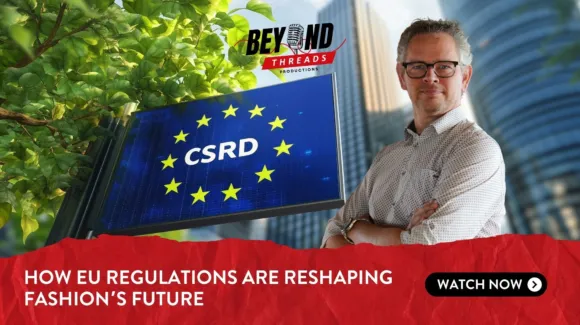The fashion industry has navigated some turbulent times in recent years. So, what can we expect in 2024? McKinsey & Company’s eighth annual State of Fashion report combines analytical perspectives from leading McKinsey experts with insights from fashion industry executives across multiple markets. Covering consumer attitudes, fashion trends, the global economy and supply chain dynamics, State of Fashion provides a detailed overview of what’s next. In this blog, we bring you the key takeaways from this insider’s guide.
Key themes for 2024
- Weak growth in major markets (the European Union, the United States and China)
- A renewed focus on pricing strategies to grow sales.
- New sustainability legislation coming into force in the EU and the US.
- Increased spending on brand marketing to create an emotional connection as consumers seek authenticity.
- A return to shopping abroad, partnerships with leisure/tourism providers and buying clothes for holidays.
1. Slower growth and lower consumer spending
Whatever you say about the fashion industry in 2024, it begins and ends with the economy.
What’s happening?
The International Monetary Fund predicts that global GDP growth could slow from 3% in 2023 to 2.9% in 2024. (p. 22) This general slowdown in growth is likely to introduce a degree of unpredictability into the fashion buying behaviour of consumers, particularly in the West.
Increasing geopolitical instability is seen by many fashion executives as the biggest risk to growth. For consumers, however, inflation remains a major influence on spending decisions in Western economies – squeezing disposable incomes, particularly in the US and Europe.
Varying impacts around the world
State of Fashion reports that economic conditions around the world are not uniform, adding to the uncertainty for the fashion industry as it tries to cater for consumers in different financial situations.
Spending is expected to be most subdued in Europe, as the continent faces the challenges of ongoing geopolitical tensions, a potential recession in Germany and a sluggish economy in the UK.
In China, the economy has been in deflation and consumers have instead been building up savings, with only a limited return to spending since the COVID-19 pandemic.
Will customers want to buy?
Overall, these factors have had a direct impact on consumers' intentions to spend on fashion. Net intentions to spend on apparel have fallen the most in Europe (-39%) and the US (-25%). Meanwhile, Chinese shoppers are 7% more likely to spend on fashion this year. (p. 29)
Executives’ views are in line with these statistics: in a survey, executives identified the Middle East, India and Asia Pacific as the most promising markets for fashion retail in 2024. (p. 15)
The ‘flight to luxury’
Not only will consumers in different markets have different purchase intentions, but the purchases themselves are expected to change. McKinsey predicts a flight to established brands, with luxury fashion likely to hold its own and even outperform the rest of the fashion industry in 2024. Investment pieces may hold their value more reliably for Western consumers on limited incomes and represent aspirational purchases for middle-class Chinese consumers, explaining the ‘flight to luxury’ across markets. (p. 17)
Accordingly, McKinsey suggests focusing on contingency planning and adjusting pricing strategies rather than further cost cutting, as discussed below.
2. Raising prices to grow revenue
Fashion retailers can respond to a worsening economic situation – high inflation, weak growth and volatile geopolitics – in a number of ways. The focus for many in 2024 will be on raising prices.
Less cost-cutting
The economic situation has prompted fashion brands to bring costs and liabilities under control. However, McKinsey reports less appetite for further economising in an industry that has already seen “widespread cost-cutting” (p. 17) in recent years.
Cost pressures are expected to ease. However, limited spending in the West means that executives continue to see few opportunities for customer acquisition and revenue growth through high-volume sales.
More price increases
As a result, executives expect to implement carefully targeted price increases. 69% of executives plan to raise prices. 25% plan to increase prices by at least 5%. (p. 15)
The luxury fashion segment continues to show a remarkable ability to increase profit margins. Therefore, luxury fashion brands can be expected to benefit the most from price increases without reducing demand. In 2022, luxury brands reported a 10% increase in economic profit after increasing sales, partly due to price increases. (pp 109-110)
Fierce competition in the middle of the market
Pricing is not only important at the top of the market: Inditex and Uniqlo have also supported profitability with effective pricing strategies. (p. 108) However, the picture for the mid-market as a whole is slightly different from that for selected retailers.
In the mid-market, price competition was fiercer and relative costs were higher, so overall margins either remained stable or narrowed. (p. 110) As a result, McKinsey expects a more tactical, limited use of pricing strategies in 2024 to avoid alienating price-conscious customers of mid-market brands.
Beware of the bullwhip effect
Despite the fashion industry's settled sentiment in favour of price increases, challenges lie ahead thanks to the ‘bullwhip effect’. Changing prices can lead to volatility in demand. Delayed investments and widespread layoffs (p. 99) have made manufacturers particularly sensitive to retailer demand. Small changes in retailer order volumes can cause much larger problems further up the supply chain.
McKinsey expects these supply chain challenges to evolve in 2024, particularly with the shift towards supply chain circularity in upcoming sustainability legislation.
3. New sustainability legislation in several markets
The fashion industry is entering a new phase where sustainability is becoming as much a regulatory issue as a marketing and PR one. Governments in several markets are proposing and implementing legislation to promote circularity or circular supply chain in fashion and reduce carbon emissions. The report notes that while some low-cost fashion retailers are likely to face challenges in adapting their business models to circular practices, the changes apply to all brands.
The key legislative changes include:
California SB 253
Large companies in the state of California will be required to report on Scope 3 (indirect) emissions. This bill has now been passed.
New York State Fashion Sustainability and Social Accountability Act
Similar to the California law, a proposed law in New York State will require fashion brands to report on their impacts. However, the law will have a much broader scope, requiring reporting on environmental, social and governance (ESG) performance throughout the supply chain.
This law has far-reaching implications for fashion logistics: logistics providers will increasingly become the channel for understanding how well people are treated throughout your supply chain.
Waste Framework Directive
This EU law requires brands to pay for the disposal of products at the end of their life. EU directives set targets for member states, which will pass their own laws to achieve the directive's goals.
Corporate Sustainability Reporting Directive (CSRD)
Following similar principles to California and New York state laws, the EU Corporate Sustainability Reporting Directive introduces a standardised way for companies to report on their ESG activities across Europe.
Eco-design for Sustainable Products Regulation
A proposed EU law to apply circularity and environmental principles to the design of individual garments, supported by the introduction of digital passports for garments. EU regulations are laws that, once adopted, have a direct effect throughout the EU.
Waste Shipment Regulation
A proposed EU law to prevent the shipment of waste to the Global South. The aim is to promote recycling and reuse within Europe.
Ban on Destruction of Unsold Goods
As part of the proposed Eco-design for Sustainable Products Regulation, the EU plans to ban the destruction of unsold clothing.
Green Claims Directive
A proposed EU law that would tighten the rules on reporting sustainability claims to customers, in a bid to prevent 'greenwashing' - misleading sustainability claims made by brands.
4. A return to brand marketing
71% of fashion executives plan to spend more on brand marketing in 2024 than they have in recent years. In contrast, only 46% plan to spend more on performance marketing. (p. 82)
Is marketing changing?
Performance marketing – a digital marketing strategy – has helped fashion brands make great strides in measuring the impact of their marketing investments. But for all its added functionality and reporting capabilities, performance marketing has become expensive. Its increasingly data-driven approach also makes it a growing privacy liability.
The likelihood that customers will be less inclined to buy in 2024 makes hard selling less effective. According to McKinsey, customers will increasingly focus on the “interests and aspirations” behind products before parting with their money (p. 83). This puts a premium on brand recognition.
Brand marketing regains importance
McKinsey predicts that this will lead to a return to brand marketing. This shift in advertising tactics will emphasise the customer’s emotional connection to the brand. Instead of ultra-targeted customer acquisition, fashion brands will be expected to refine their brand storytelling. Effective brand marketing will help their label stand out in a saturated market.
Authentic brands use authentic tactics
The economic shifts driving change in marketing go hand in hand with the recent trend towards authenticity in customer interactions. A popular tactic in modern brand marketing is to highlight the personalities behind the brand (p.84). McKinsey suggests that customers naturally gravitate towards familiar faces, making it easier for personalities to create compelling organic content about products rather than brands directly.
Other brands may focus on social action and sustainability, or the unique qualities of the advertised products. All of these tactics demonstrate the versatility, authenticity and cost-effectiveness of brand marketing - all attractive advantages for fashion executives in tough times.
5. More travel time outdoors
McKinsey reports that customers are increasingly focused on their personal health and well-being (p.53). In addition, various economic factors and the post-pandemic return of Chinese tourists will make holiday shopping more important in 2024 than it has been for some years (p. 40).
Holiday fashion
These developments will directly benefit the fashion and lifestyle industries, with more outdoor clothing being purchased. As global travel picks up after the pandemic, McKinsey reports that holiday fashion will be a “key beneficiary of travel growth” (p. 38). In fact, nearly 40% of consumers buy new clothes before going on holiday.
The return of Chinese tourism
In addition, Chinese outbound travel is expected to reach 70 to 100% of pre-pandemic levels. (p. 40). Accounting for a fifth of international shopping spend, this huge influx of consumers after the long pandemic closure means that tax-free overseas shopping will return in a big way in 2024.
Meeting the customer where they are
With this in mind, fashion brands should develop partnerships with leisure and tourism operators to create branded experiences and pop-ups that meet potential customers where they are. Whether in the great outdoors or in major tourist destinations, effective fashion logistics will be key to engaging customers outside of their – and your brand’s – usual environment.
Fashion in 2024
Although the fashion industry faces significant challenges in the coming year there are also many opportunities for brands that can adapt to the changing retail landscape. Why not get in contact with a Bleckmann expert today? We can help you understand how your brand can meet consumer and regulatory expectations in the years to come.













